If you run a website, then you need a CMS.
A content management system (CMS) is software that helps you create and manage your website’s content.
It makes it easy to publish articles, update pages, and add images.
Without a CMS, you would have to manually edit your website’s HTML code every time you want to make a change.
This process would become time-consuming and difficult for non-techies.
In this article, we discuss the most effective content management systems.
We’ll cover both regular websites and eCommerce sites, so you can find the best CMS for your needs.
We’ll also show you why WordPress.org comes in as our top selection.
Contents
An Overview of Content Management Systems
Let’s quickly review the overall concepts behind content management systems.
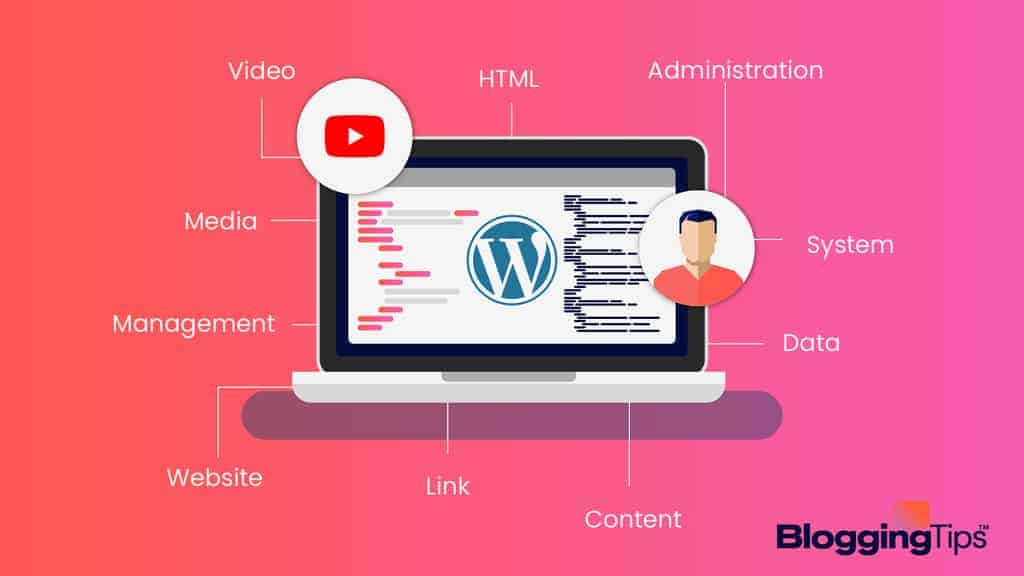
What Is a CMS?
Content management systems are software programs that help you create, manage, and publish content.
There are many different types of content management systems available, ranging from simple to complex.
Some common features include the ability to do the following:
- Create and manage users
- Create and manage content
- Format and publish content on the web
- Store and organize content
- Search for content
- And much more
What Role Does a CMS Play in Marketing?
A CMS can be an essential tool for marketing teams.
It can help you easily get content on your website, track user engagement, and measure your results.
Additionally, a CMS can help you manage your website’s SEO and social media presence.
Our Favorite Options: Summarized
Although we’ll give you full details below, here is a quick summary of our favorite CMS options.
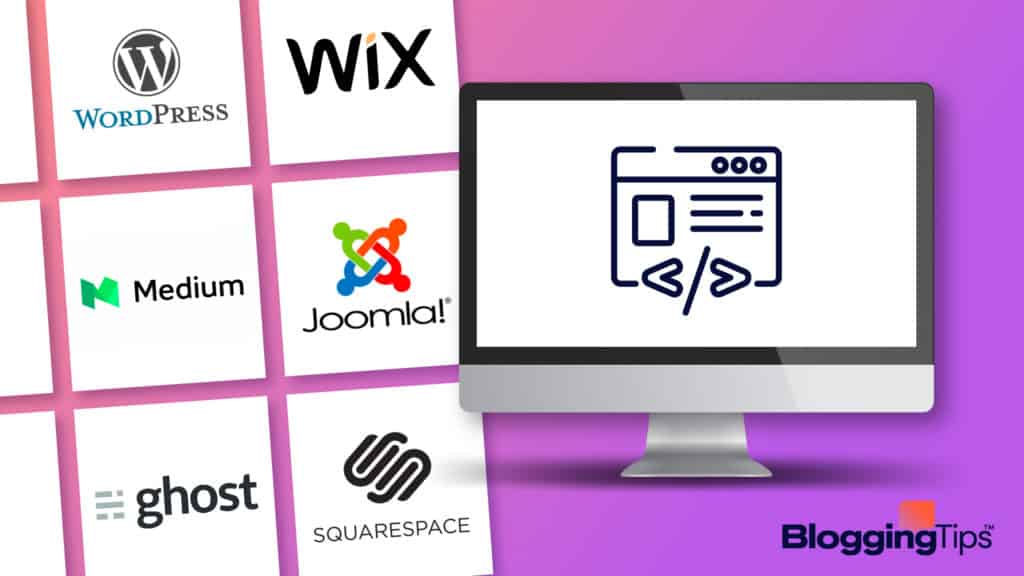
Who Is the Best CMS in the World?
WordPress.org has secured its place as the most popular CMS worldwide, and it’s not hard to see why.
We rank it as our favorite CMS because of its ease of use, flexibility, and vast ecosystem.
The platform is a quality choice for small businesses, bloggers, and anyone who wants to build a website without learning code.
Which CMS Framework Is Best?
We rank Drupal as the best CMS framework.
Developers who want to create custom websites and applications typically use it.
Drupal is highly extensible, meaning you can add new features and functionality as needed.
Additionally, it boasts a strong security track record over time.
What Is the Most Common CMS?
Once again, WordPress.org ranks well.
It powers more than 40% of all websites on the internet.
That number may climb as additional website owners look for a simple solution to their CMS needs.
What Is the Best CMS for Developers?
Joomla is our top pick for developers.
It’s an open-source CMS with a large developer community.
Joomla works well for developers who want to create complex websites and applications.
Best CMS Options For 2022
Let’s begin with our top 10 CMS picks for regular websites.
1. WordPress.com
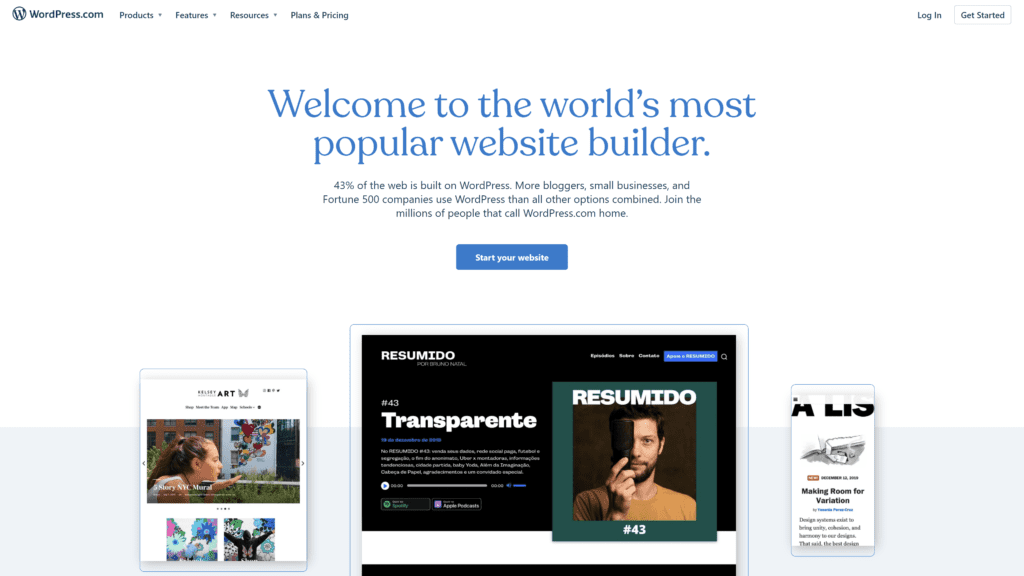
WordPress.com is a blogging site that’s utilized by millions of people around the world, including some of the largest websites on the internet.
It’s owned by Automattic, which also owns WordPress.org.
The platform is easy to use, and you can create a website in minutes.
Our Rating
Five
Best For
Ease of use and pricing
Notable Features
- Integrated blogging tools: With WordPress.com, the ability to moderate comments, establish categories and tags, and publish content is all part of the package. You can integrate with social media platforms, too.
- Custom domain: For an annual fee, you have the option to buy a custom domain through WordPress.com. It’s a crucial feature because it allows you to build a brand and establish yourself as a credible website.
- Plugins and themes: WordPress.com boasts various free themes and plugins. Use these items to enhance the functionality and design of your website.
Pros
- All-in-one solution: WordPress.com combines a domain name, hosting, and email services in one location.
- Community: The platform boasts a vast community and provides free support to its users.
- Easily back up data: WordPress.com ensures your site data is constantly backed up. A backup process helps you avoid data loss in the event of an unforeseen incident.
- Security and hosting: Automattic provides all of this for you, so you don’t have to worry about it. WordPress.com manages and protects your site.
- Ease of use: If you’re unfamiliar with self-hosting websites, this platform is a simple option to get started on and use.
Cons
- You don’t own your content: Unlike WordPress.org, you don’t technically own your content on WordPress.com, which means running into transfer headaches if you ever want to move your site.
- Limited options for customization: WordPress.com doesn’t allow you to install custom plugins or themes. As you advance your website-building skills, this may become frustrating.
- Less control: You have less control over your website than you would with self-hosted options. Remember, you’re using someone else’s platform.
Is WordPress.com Hard To Use?

WordPress.com isn’t challenging to use since it’s designed for individuals who come in new to the website creation process.
Pricing & Plans
WordPress.com offers a free and premium plan.
You may try the service for free and then upgrade to one of two paid plans.
- WordPress Starter: $5 per month
- WordPress Pro: $15 per month
Our Take
WordPress.com is a simple platform to learn and use.
WordPress.com’s free edition is an excellent choice for individuals who want to set up a basic blog or website.
For additional functionality, you may upgrade to one of two premium pricing plans.
2. WordPress.org
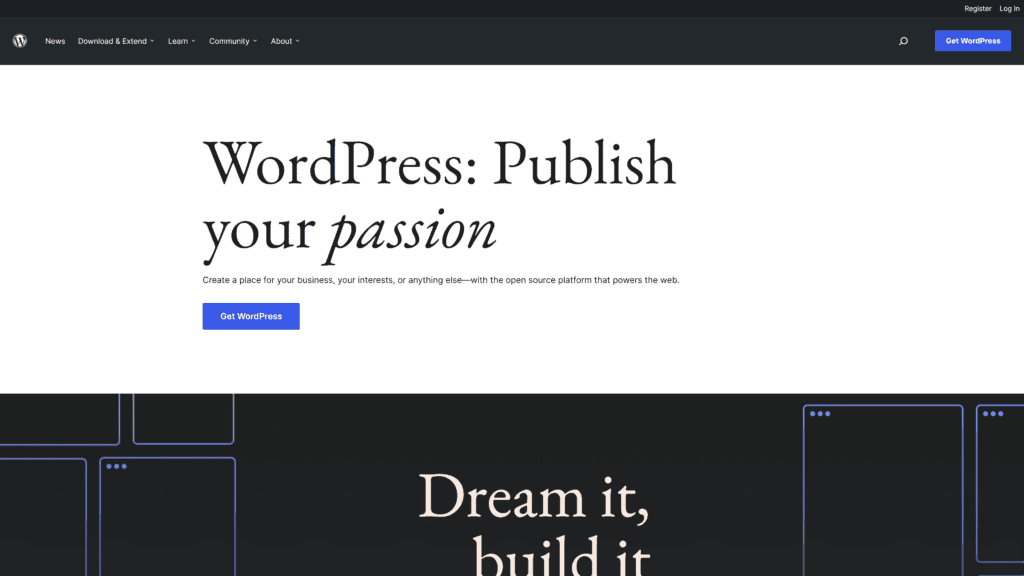
WordPress is a CMS that runs on the WordPress.org platform, which is free and open-source.
It’s probably the most popular free blogging software in the world, with millions of users from all around the globe using it.
Our Rating
Five
Best For
Self-hosted websites
Notable Features
- Flexibility: You can use a WordPress.org account for a wide range of sites, from a personal blog to an organization’s website.
- Options for customization: If necessary, you may further customize your theme’s code or hire a developer to assist you.
- Plugins and themes: With this platform, you may use various free and paid themes and plugins, as well as build custom themes and plugins.
Pros
- Memberships and stores: You can use the platform to design a membership website or an online store. Use these options to generate revenue for your site.
- No ads: Removing advertisements from your site (compared to using WordPress.com) represents one of the most advantageous aspects of WordPress.org.
- Web development options: WordPress.org works just as well for website development as it does for eCommerce stores.
- 100% control: With WordPress.org, you have total control of your website. This control includes the ability for more experienced users to modify their site’s code.
- Cross-platform: You may visit your WordPress website from any device with an internet connection, making it one of the most flexible CMS platforms available.
Cons
- Frequent updates: It’s critical to keep your WordPress.org site up to date, which might be difficult for some people to continue doing.
- More difficult to use: WordPress.org may appear challenging for beginners since it requires you to establish and take care of your domain name, hosting, and website.
- Requires self-hosting: You’ll need to acquire and pay for your web hosting, which means it will be more expensive than a CMS like WordPress.com.
Is WordPress.org Hard To Use?
WordPress.org isn’t as simple to use as some other CMS options.
However, if you’re willing to put in the effort, it’s not difficult to learn.
With a little practice, you can produce an attractive website with ease.
Pricing & Plans
There are no official pricing plans offered by WordPress.org.
It’s a free CMS.
However, you will have to pay certain expenses as follows:
- Web hosting: You’ll typically pay $25-$100 per year
- Domain name: Typically runs about $15 per year
- Premium themes and plugins: Might range from $50-$200
Our Take
Overall, we believe WordPress.org is the best CMS for most business owners and marketers.
If you’re willing to put in the effort to master it, you can build a beautiful and optimized website.
Consider the required costs for hosting and premium themes, and use a top-notch CMS solution to create your website.
3. Ghost
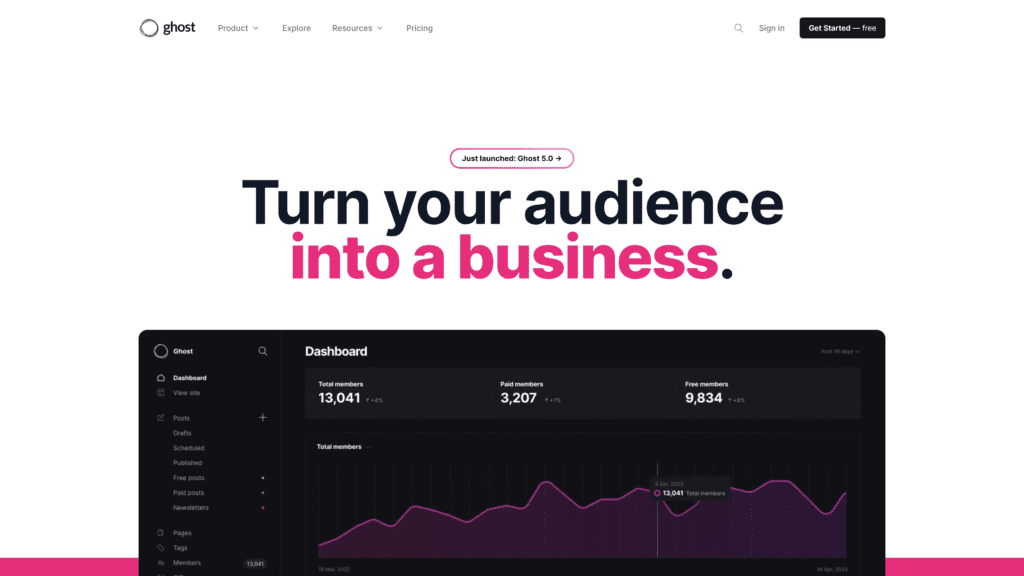
Ghost is a free and open-source CMS that is easy to use, quick, and attractive.
It’s an ideal platform for those who want something simple and lightweight.
You can also access more features by upgrading to a paid plan.
Our Rating
Four
Best For
Lightweight blogging
Notable Features
- Publication: On Ghost, you can design a publication that collects articles from various authors.
- Themes: There are numerous free and premium themes accessible through the platform’s store.
- Code injection: Adding code snippets to your Ghost blog is an easy way to change its appearance. Use the feature to add custom CSS, JavaScript, or HTML.
Pros
- SEO: Ghost gives you built-in SEO tools to help you get the most ranking traction.
- Membership management: You can enable the premium version to manage memberships and grant members access to your publication.
- Minimalistic: Some users decide to use Ghost because of its simplicity. Experience with CMS isn’t required.
- Markdown support: It’s easy to format your posts using Markdown in Ghost, which is another reason it’s a quality choice.
- Website speed: Ghost offers one of the fastest CMS platforms available. Your users will navigate quickly from page to page.
Cons
- Lack of features: Some users might see the lack of features on Ghost as a major negative.
- Free use doesn’t come with support: Since the platform is open-source, you won’t benefit from customer service. It could become a struggle for newbies to proceed without support.
- Limited options for customization: There aren’t as many choices for customization on Ghost as you’ll discover with other CMS options.
Is Ghost Hard To Use?
No, Ghost isn’t complicated to use.
It’s quite the opposite.
The platform provides a minimalistic approach that makes it easy to navigate.
Pricing & Plans
Select from these four pricing plans:
- Starter Plan: $9 per month
- Creator Plan: $25 per month
- Team Plan: $50 per month
- Business Plan: $199 per month
Our Take
For those who want a lightweight CMS experience, Ghost works well.
The free edition is ideal for personal use.
However, if you need more features or assistance, you’ll have to upgrade to a paid account.
4. HubSpot CMS Hub
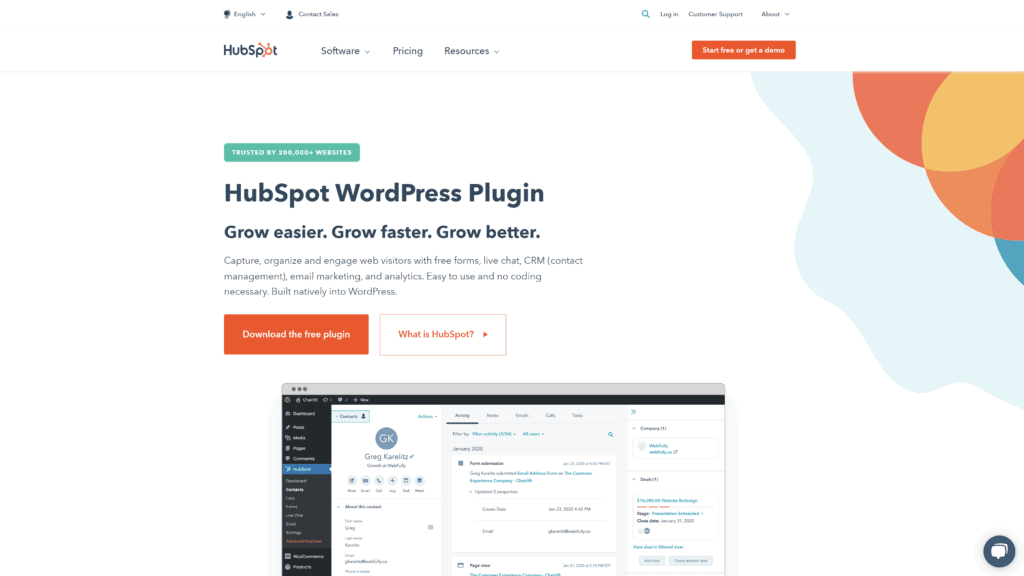
The CMS Hub from HubSpot is a powerful tool that’s perfect for businesses of all sizes.
From small businesses to enterprises, this platform has all the features you need to succeed.
Our Rating
Five
Best For
Small to medium-sized businesses
Notable Features
- Pages: HubSpot CMS provides everything you need to create and design responsive pages that look great on all devices.
- Blogging: The platform makes it easy to blog and provides tools to help you optimize your posts for SEO.
- Lead capture: HubSpot CMS comes with lead capture forms and pop-ups to help you convert website visitors into leads.
Pros
- Easy to use: HubSpot CMS is one of the easiest CRMs to use. You don’t need coding skills or experience with CRMs to get started.
- Adaptive testing: HubSpot makes it simple to continually optimize your website. Test alternative versions of a page against one another to see which performs best. HubSpot will evaluate performance and display the optimum selection based on the results.
- Drag-and-drop editor: Create, update and delete pages without the assistance of a developer or custom code. It’s never been easier to make changes on the go.
- Website themes: With HubSpot, easily create a uniform website by choosing from one of the many themes. Or, opt for custom development to produce a unique site. Regardless of your choice, you won’t have to worry about inconsistencies between navigations, logos, or designs.
- Contact attribution reporting: Examine the influence of your website and fine-tune your plan by looking at which content campaigns, sources, and types produce the most prospects.
Cons
- Limited hosting: You must host your website with HubSpot. You can’t host elsewhere.
- Paid features: You may need to upgrade to a more expensive plan to access all the features you need.
- Limits with languages: You may become frustrated with the lack of multi-language functionality.
Is HubSpot CMS Hub Hard To Use?
No, HubSpot CMS Hub isn’t complicated to use.
Users of all skill levels should find it simple.
It provides everything you need to create a responsive website.
Pricing & Plans
You can select from three HubSpot CMS Hub pricing plans:
- Starter Plan: $23 per month
- Professional Plan: $360 per month
- Enterprise Plan: $1,200 per month
Our Take
HubSpot CMS Hub provides everything you need to create a quality website.
You can also use the HubSpot CMS Hub to test alternative versions of a page against one another to see which performs best.
However, you can’t host your website with HubSpot CMS Hub elsewhere.
Despite this limitation, the platform offers one of the best options on the market.
5. Joomla
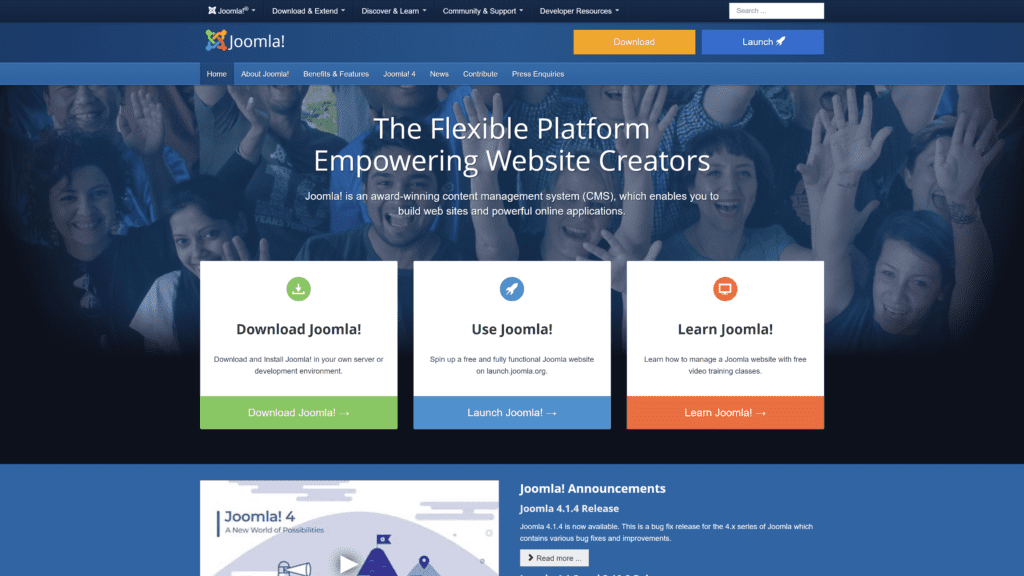
Joomla is a CMS that allows you to create web pages.
Its developers based the platform on a specific type of web application architecture that you can use with and without the CMS.
Joomla appeals to more experienced developers because of its free add-ons, extensions, and templates.
Our Rating
Four and a half
Best For
Developers
Notable Features
- Database abstraction: A database abstraction layer allows you to utilize many types of databases.
- Control website access: Keep your website safe from intruders with various security features. Use this feature to control who can see or make changes to your website.
- Templates: Joomla allows you to download free add-ons and templates.
Pros
- RSS feeds: Manage your material with Joomla. An RSS feed is automatically generated for every article you create.
- Blog features: Joomla works perfectly when creating a blog.
- Extensions: The extensions allow you to personalize your blog however you wish.
- Tutorials: The site provides developer help via various training courses.
- Easy to use: If you know how to code, Joomla is easy to work with.
Cons
- Template limitations: Joomla doesn’t give you as many free templates as other platforms do.
- Slowdowns: You may experience slow periods while using Joomla.
- Not as user-friendly as other options: In comparison to WordPress, Joomla is not user-friendly and may require some coding skills to properly make use of the platform.
Is Joomla Hard To Use?
Joomla is one of the more difficult CMS systems to master.
It’s best if you come in with HTML and CSS knowledge.
If you’re not a coder, you might want to consider one of the drag-and-drop CMS options.
Pricing & Plans
Joomla is free to download.
Our Take
Joomla may be a little intimidating to those new to website creation or design.
The learning curve is higher than that of some of the other CMS platforms on our list.
It’s ideal for advanced coders.
Give Joomla a shot if you’re an experienced developer.
6. Drupal
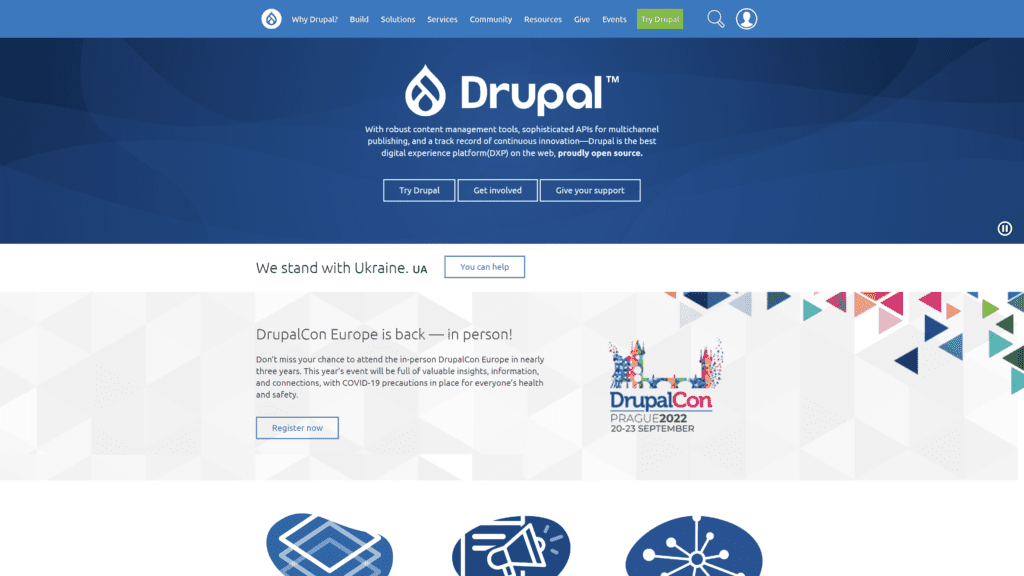
Drupal is a powerful CMS that works best for developers with intermediate coding skills.
The platform is free to use and open-source.
You can create blogs, eCommerce stores, and more with Drupal.
Our Rating
Three
Best For
Developers with some coding skills.
Notable Features
- Security: Drupal comes with a good reputation when it comes to security. Security features include two-factor authentication and password policies.
- Performance: Speed and performance features make this CMS a quality selection. For example, it can handle high traffic loads without crashing.
- Flexibility: You can use Drupal to create a wide range of websites, from blogs to eCommerce stores.
Pros
- Free: Drupal is free to use and open-source.
- Performance: Drupal is one of the best-performing CMS systems. For instance, it can handle high traffic loads without crashing.
- Prioritizes accessibility: Every user, regardless of their device or abilities, should be able to have a great experience when they access sites. Drupal ensures that its features meet the requirements of the World Wide Web Consortium.
- Theming: Drupal offers an advanced theming engine. You can create almost any type of website with the CMS.
- Robust platform: Drupal websites are powerful. It’s a platform where you can build a stable and streamlined website to deliver content users can easily access.
Cons
- The learning curve: Drupal has a steep learning curve. It’s not the best platform for beginners.
- Security issues: Although secure to the public, any developer with basic knowledge of the platform’s code can discover security flaws and launch cyberattacks. If your site handles sensitive or personal data, you want to avoid this.
- Support challenges: Open-source software comes free and isn’t owned by any company. There’s no customer service to help you if you have questions or need assistance.
Is Drupal Hard To Use?
Drupal is one of the more difficult CMS systems to use.
It’s best if you come in with HTML and CSS skills.
Pricing & Plans
Drupal is free to use.
Our Take
Drupal is best for developers with some coding skills.
The learning curve is higher than that of some of the other CMS platforms on our list.
Give Drupal a shot if you’re an experienced developer.
7. Wix

If you’re looking for a CMS builder that doesn’t skimp on features, Wix is an option.
With Wix, you can create a professional portfolio, an eCommerce website, or a blog.
Plus, building a blog with Wix is easy and comes with plenty of competitive features.
Our Rating
Four
Best For
Unique website creation
Notable Features
- SEO tools: Wix gives you free access to SEO tools that can improve your blog’s search engine ranking results.
- Free hosting: If you host your blog on Wix, you’ll get free website hosting and automatic updates from the company.
- Blog templates: Wix provides you with an assortment of 200+ templates so you can find the perfect design for your blog.
Pros
- Quick page load times: Wix provides a content delivery network (CDN) as part of its hosting plan, which may help with faster website loading times.
- App market: Wix offers you 250+ applications inside its app market. It allows you to add features, such as social media feeds, email marketing, and live chat, to your website.
- Domain name: Wix offers the option of buying a custom domain name directly from them (on one of the premium plans).
- Integrated eCommerce: Wix lets you post products on your blog and sell them directly to customers.
- Host paid events: Wix allows you to run sponsored events on your blog and accept payments. For example, you can run workshops, webinars, and other paid events.
Cons
- Wix branding: Wix plans also come with Wix branding in the footer of your website.
- Storage limits: The free plan Wix offers only gives you 500MB of storage. If you want to host a lot of multimedia content inside your CMS, this won’t be enough for you.
- Ads: Unless you upgrade to a premium plan, you and your visitors will see Wix advertising on your site.
Is Wix Hard To Use?
Even if you’re new to website building, Wix is easy to use.
Wix’s interface will guide you through each step of creating a website.
Pricing & Plans
The company offers four pricing plans:
- Combo Plan: $16 per month
- Unlimited Plan: $22 per month
- Pro Plan: $27 per month
- VIP Plan: $45 per month
Our Take
Wix is a CMS with a distinct look and feel.
The site offers several features, including the app market, sophisticated SEO tools, website hosting, and templates.
WordPress.com is a fantastic alternative if you’re searching for a platform without many restrictions.
8. Squarespace

Squarespace is a well-known CMS with a clean, modern design.
Even people with no prior experience can easily navigate the tool.
Squarespace has a free and paid version.
If you want to use the site regularly, you’ll need to upgrade to a premium plan.
Our Rating
Five
Best For
Visual design
Notable Features
- eCommerce options: Use Squarespace to set up an online store inside your CMS for easy product selling.
- Design tools: With Squarespace, you can create a distinctive appearance for your website using the CMS drag-and-drop tools.
- Layouts: Squarespace offers plenty of customizable layouts, ranging from single-column blogs to alternating sides and side-by-side grid columns.
Pros
- SEO help: Squarespace gives you various SEO tools to help you upgrade your content and stand out on search engines. Use these features to add metatags, create sitemaps, and more.
- Gain exposure: Squarespace’s integrations urge readers to share your material on social platforms using social media buttons. Getting shared on social media can help you gain more website traffic.
- Feature posts: On Squarespace, you can highlight blog posts to make them more visible. A feature post will appear at the top of your blog page and you can change it whenever you want.
- Track analytics: Squarespace makes it easy for you to see how your audience engages with your content. Use this data to adjust your strategy accordingly.
- Manage daily workflows: Squarespace can assist you with remaining organized when managing a team or working with clients.
Cons
- No app or plugin support: You can’t ask for customer support when installing third-party tools or applications. It could frustrate you if you’re new to working with CMS options.
- No free plan: Although Squarespace provides a free trial, you must enter your credit card information to begin. If you don’t upgrade to a paid plan, you’re automatically unable to use the platform beyond the trial period.
- Customization limitations: Squarespace provides a large number of templates. However, you can’t customize them. If you want extensive customization capabilities, you should look somewhere else.
Is Squarespace Hard To Use?
No, Squarespace isn’t difficult to use.
The platform works easily, no matter your level of expertise.
Even if you’ve never published with a CMS before, Squarespace’s simple dashboard can help you generate a professional-looking site.
Pricing & Plans
There are four distinct pricing options for Squarespace:
- Personal Plan: $16 per month
- Business Plan: $23 per month
- Basic Commerce Plan: $27 per month
- Advanced Commerce Plan: $49 per month
Our Take
If you’re a creative type who wants to write and share your stories, Squarespace is the perfect CMS.
With its simple and elegant interface, it’s much easier to use than some of the other options out there.
However, it doesn’t offer as many features as some of the others do.
9. Blogger

Blogger is one of the most popular CMS options on the internet, and it’s a Google property.
You can use a custom domain name with Blogger or sign up for a free blogspot.com account.
There are three methods to establish a Blogger site: creating a Google account, establishing an official Blogger account, or using your Gmail account.
Our Rating
Three and a half
Best For
Blogging without hosting fees
Notable Features
- Build a blog from a phone: The Blogger app allows you to edit your website right from the app. You may even send text messages and pictures to your blog using a smartphone.
- Google product integrations: It integrates well with other Google platforms like Adsense. For instance, you can connect to AdSense using the “Earnings” tab.
- Template design: You may modify the appearance and feel of your blog using the Template designer without needing to know HTML.
Pros
- Add videos easily: When you create a new blog article, Blogger’s CMS automatically adds a “Video” button at the top of the screen. Use it to search YouTube for videos and embed them in your posts automatically. Alternatively, copy and paste a video from your computer into your post.
- Free templates: Blogger gives you multiple options for customizable templates.
- Dynamic views: This feature gives readers the ability to select how they want to view your blog posts.
- Customizable design: You may make color, font, and background modifications to your blog without having to know HTML using the Template designer. Use drag-and-drop functionality to create any required adjustment.
- User-friendly interface: Blogger is straightforward to use, and anyone can create a blog in minutes.
Cons
There are a few limitations to using Blogger.
- Encryption: There’s no way to encrypt password entries.
- It can be slow: Blogger brings with it a reputation for being sluggish. Many users have complained that it runs slowly, particularly when they first begin using it.
- Support issues: As with most Google products, it’s difficult to access a person for customer service.
Is Blogger Hard To Use?
Blogger is one of the simplest free blog platforms to use since you don’t need to understand code.
In less than five minutes, you can create a blog and add functionality with Blogger’s widgets.
Pricing & Plans
Google offers all of Blogger’s capabilities for free.
You’ll need to go to Blogger’s home page and use your Google login credentials.
Our Take
Blogger is a simple blogging platform that’s ideal for individuals who don’t want to spend money on hosting.
Blogger offers an easy-to-use interface with lots of free templates and tools.
10. Magento
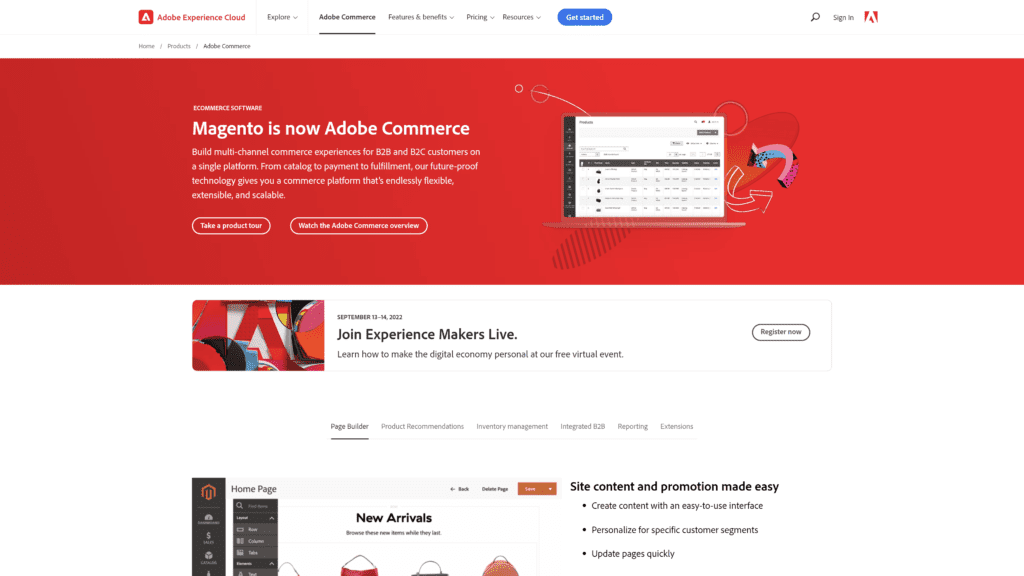
Magento is now called Adobe Commerce.
It provides quality out-of-the-box features that aid the B2B and B2C shopping experience.
With this tool, you’ll gain access to an international network of third-party integrations, a marketplace of extensions, and implementation partners for excellent eCommerce customization.
Our Rating
Four
Best for
Omnichannel fulfillment
Notable Features
- Mobile devices: Select a mobile commerce solution that works with your consumers no matter where they live. Using its progressive web application (PWA), you can create seamless website experiences that appear well on all devices.
- Multi-branding: From a single platform, you may handle all of your brands and serve all of your consumers through various digital channels.
- Channel Manager: The feature streamlines the process for integrating Magento Open Source stores with the Walmart Marketplace.
Pros
- Free software version: It’s available for open-source download. However, the free edition provides fewer features and doesn’t include security or hosting.
- Omnichannel: After you download the app, it provides links to connect your online store as well as any physical shops or other marketplaces where you sell.
- Customization: Although it requires a time and resource investment, you can fully customize your online shop.
- Scalability: As your business expands, this open-source solution can grow with your business.
- SEO tools: You get access to a comprehensive suite of built-in SEO tools.
Cons
- Hard to navigate: It’s particularly difficult to use, and you’ll need help from experts to set up and update your online store regularly.
- You provide the server: It’s hard to do this when you’re unsure how much traffic your website will generate in the beginning.
- Cost: This CMS option will cost you money for the server, domain, and various tools, as well as the expenses of security measures, software updates, and developers.
Is Magento Hard To Use?
Yes, Magento is quite difficult to use, especially for those without coding skills.
We recommend working with a developer or agency if you plan to use this platform.
Pricing & Plans
You must contact Adobe Commerce (formerly Magento) to obtain pricing details.
Our Take
Adobe Commerce is a good choice for businesses looking for an omnichannel platform with scalability.
However, the platform can be difficult to use and may require the help of a developer.
Adobe Commerce’s prices are also not readily available.
Overall, we recommend this platform for larger businesses.
Best CMS Options for eCommerce
Let’s review the four top CMS options for running an eCommerce business.
1. WooCommerce
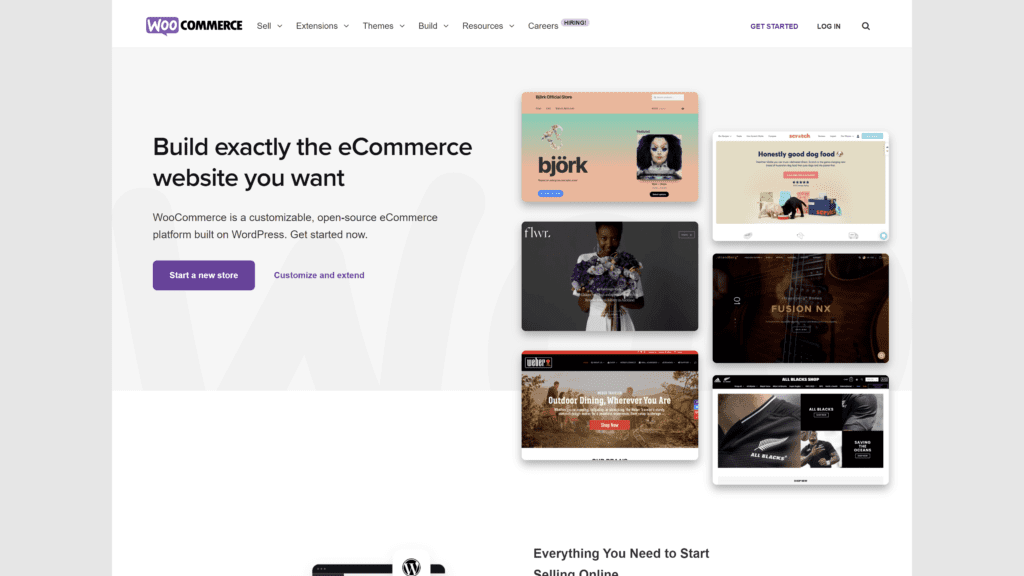
WooCommerce is a WordPress plugin that turns your WordPress site into an online store.
It’s one of the most popular eCommerce platforms on the web because it’s easy to use and provides a lot of features.
Our Rating
Four and a half
Best for
Small businesses that use WordPress
Notable Features
- Product management: You can manage an unlimited number of products with ease.
- Payment options: You can accept payments through various methods, including PayPal, Stripe, and Apple Pay.
- Shipping: WooCommerce offers a variety of shipping options, including flat rate shipping, free shipping, and local pickup.
Pros
- Easy to use: WooCommerce is one of the easiest platforms to use. You can set it up and start selling in no time.
- Flexibility: It’s a flexible option. You can add a variety of plugins to add more features to your online store.
- Affordable: WooCommerce is a free platform. You only have to pay for hosting, domain, and any plugins or themes you add.
- A large community of contributors: WooCommerce has a large community of developers and contributors who add new features and updates regularly.
- Regularly updated for security: The plugin receives regular updates, so you can rest assured your store will remain secure.
Cons
- Limited features: WooCommerce doesn’t have as many features as some of the other platforms on this list.
- No customer support: WooCommerce doesn’t offer any customer support with the free plugin. You’ll have to rely on the WooCommerce community or hire a developer for help.
- Paid extensions: Some of the best features are only available through paid extensions.
Is WooCommerce Hard To Use?
No, WooCommerce isn’t hard to use.
It’s one of the easiest platforms to set up and use.
Pricing & Plans
WooCommerce is a free platform.
You only have to pay for hosting, domain, and any extensions you add to your site.
Our Take
WooCommerce is a quality platform for small businesses that use WordPress.
It’s easy to use and provides a lot of features.
However, it doesn’t have as many features as some of the other platforms on this list.
Although you’ll need to pay for some extensions, it’s a solid choice.
2. Shopify

Shopify is a market leader in the world of eCommerce.
It’s simple to use and has a lot of features.
It works with all of your other business tools, such as social media platforms, email service providers, and accounting software.
Our Rating
Five
Best For
Online stores
Notable Features
- Marketing tools: To help you market and expand your business, Shopify gives free and paid marketing tools.
- The blog features: The team at Shopify knows that eCommerce firms should look at using blogging to attract consumers to their items. Add blog posts to your online store with ease using the platform.
- Beautiful modern themes: Shopify provides a plethora of design choices for your website and store, with free and premium themes available.
Pros
- Shopping cart: You can sell your items online using the platform’s built-in shopping cart, which is highly configurable.
- One simple dashboard: All the resources you’ll need to run your company are available in one location. The dashboard is relatively simple to use after you become used to it.
- Quality free trial: Try Shopify free of charge for two weeks with no credit card required.
- Top-notch tutorials: The eCommerce team offers guides and instructions to assist you in getting the most out of your store and blog.
- Customer service: All Shopify users can expect fantastic customer support.
Cons
- Paid add-ons: Although Shopify provides a monthly subscription plan, there are several additional fees that you’ll have to consider before signing up. You’ll need to budget for add-ons like the plugin that allows your visitors to get discounts.
- No forever-free plan: It’s beneficial to open a Shopify account without a credit card. However, there isn’t a “free for life” option from this CMS.
- Pricing: Shopify’s pricing is higher than some of its competitors. However, its various features and top-notch customer support make it worth the extra cost.
Is Shopify Hard To Use?
If you’re new to Shopify, some features and terminology may give you trouble.
Additionally, the dashboard isn’t as user-friendly as other options available.
However, don’t worry.
There are plenty of resources to help get you started, like tutorials and a customer support team that responds rapidly.
Pricing & Plans
You can upgrade to one of Shopify’s three paid plans after your free trial.
These plans are as follows:
- Basic Plan: $29 per month
- Shopify Plan: $79 per month
- Advanced Plan: $299 per month
Our Take
Although Shopify isn’t a conventional CMS, it does include several elements beneficial to an eCommerce firm.
You may get the best of both worlds by using Shopify.
The platform allows you to list and sell items.
It also enables you to add blog responsibilities for better search engine optimization benefits.
3. BigCommerce

BigCommerce is an eCommerce-based platform that gives users everything they need to create an online store.
It’s best for businesses working to expand their operations.
Our Rating
Five
Best For
Large stores
Notable Features
- Abandoned cart recovery: The platform will send automatic emails to customers who start the checkout process but don’t complete their purchases. Use this feature to boost sales and customer retention.
- Third-party integrations: You can connect your BigCommerce store to other business software you’re using, such as accounting and marketing platforms. Integrations help to streamline your workflows.
- Multi-channel selling: Sell your products on your website, social media, marketplaces, and in-person using BigCommerce. The company decided to build the concept of omnichannel selling into the platform.
Pros
- Scalability: The platform can help businesses scale through features that accommodate an increase in traffic and sales. Features like this show why BigCommerce works best for larger stores.
- Fantastic customer support: You can contact the BigCommerce team 24/7 through live chat, email, or phone. Use this option when you need help with anything from technical issues to design advice.
- Real-time shipping quotes: Customers will see shipping fees before they finalize their purchase. Remaining upfront with shipping costs is an excellent way to avoid abandoned carts.
- Product reviews: You can add customer reviews to your product pages, which helps with conversion rates.
- A/B testing: Test different aspects of your website to see what converts best into sales. For example, try out different product descriptions or images.
Cons
- Locked into the platform: Once you start using BigCommerce, it may be difficult to switch to another eCommerce platform. However, you can grow with a BigCommerce account, which mitigates this negative aspect.
- Pricing: The pricing plans are more expensive than other platforms on our list.
- No free trial: Unlike Shopify, BigCommerce doesn’t offer a free trial. You’ll have to provide your credit card information when signing up.
Is BigCommerce Hard To Use?
BigCommerce is a complex platform with a lot of features.
It may be difficult to use if you’re new to eCommerce or website building.
However, the customer support team is excellent and can help you with any issues.
Pricing & Plans
You’ll need to contact BigCommerce for a pricing quote.
Our Take
BigCommerce is best for businesses that are planning to grow their eCommerce store.
The platform has features that accommodate an increase in traffic and sales.
Additionally, the customer support team is available 24/7 to help you with any issues you may have.
4. PrestaShop
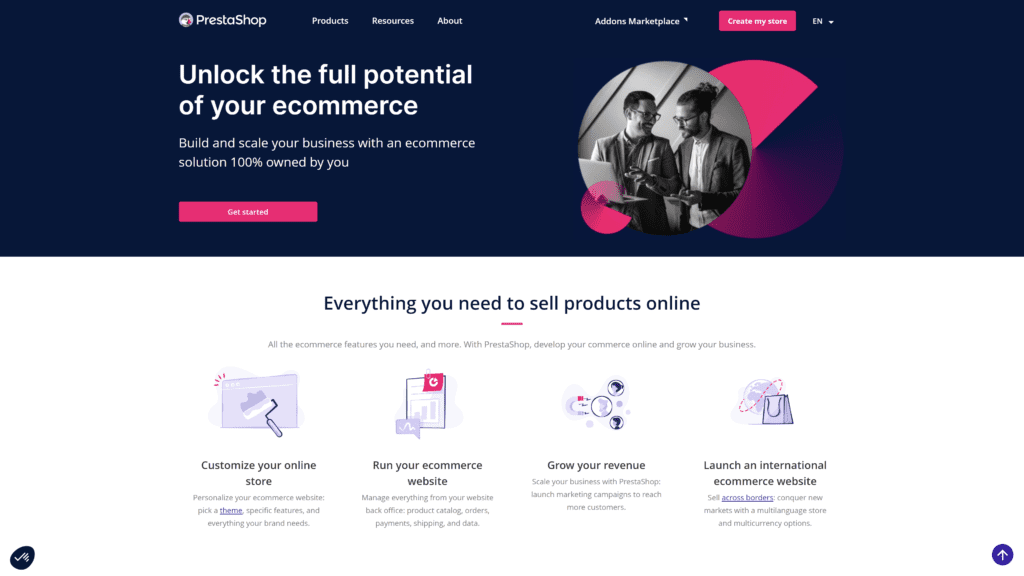
PrestaShop is an eCommerce platform that provides free software for businesses to create an online store.
The software is open-source, meaning anyone can contribute to its development.
Our Rating
Four
Best For
Small businesses
Notable Features
- Quick set-up: With PrestaShop, you can create a store in less than an hour. This ability is thanks to the platform’s easy-to-use interface and pre-designed themes.
- SEO features: The platform comes with built-in SEO features, such as customizable URLs and automatic sitemaps. These features help your store rank higher on search engine results pages.
- Abandoned cart recovery: Use PrestaShop’s automatic emails to revive customers who don’t finish a purchase visit. You’re more likely to bring these customers back if you contact them immediately through this automation feature.
Pros
- Free to use: PrestaShop is free to download and use. You’ll only need to pay for hosting, a domain name, and any third-party add-ons you use.
- Easy to add products: With PrestaShop, you can add an unlimited number of products to your store. It’s helpful if you have a large inventory or plan to expand your product offerings in the future.
- Plenty of themes: Choose from thousands of themes and modules to find the perfect look for your store.
- Product navigation features: Customers can filter products by price, brand, or type. It makes it easier for them to find what they’re looking for on your website.
- Payment methods: You can accept payments through PayPal, Stripe, or more than a dozen other payment methods.
Cons
- Limited scalability: PrestaShop can’t handle a large influx of traffic or sales. If you’re expecting rapid growth, you may need to look for a different platform.
- Lack of customer support: Because PrestaShop is free to use, there’s no customer support team to contact if you have questions or need help.
- Unprofessional design: Some free themes and modules have an unprofessional look. If you want a more polished store, you’ll potentially need to use a different CMS.
Is PrestaShop Hard To Use?
PrestaShop is easy to use, even if you’re new to website building.
The platform gives you a user-friendly interface.
If you have any questions, there are plenty of online resources, such as support pages, that can help you.
Pricing & Plans
You can download PrestaShop free of charge.
Click the “Get Started” button on the home page to begin your account.
Our Take
PrestaShop is best for small businesses on a tight budget.
Additionally, PrestaShop is easy to use, even if you’re new to building eCommerce businesses.
However, the platform lacks scalability and customer support.
If you’re expecting rapid growth or need help with using the platform, you may need to look for a different CMS.
How To Choose a CMS for Your Website
Before selecting your CMS, consider the following factors.

1. Ease of Use
You should be able to use your chosen platform with ease, regardless of your technical background and coding skills.
The best CMS platforms will have a user-friendly interface and intuitive controls.
It’s an important consideration because you don’t want to spend your time learning how to use the system.
On our list, HubSpot CMS Hub, WooCommerce, Wix, and WordPress.com score high marks in this area.
2. Price
Quality CMS options will offer various pricing options to suit your budget.
Some providers may offer a free version of their software with limited features, and others may require a subscription fee for full access to the platform.
3. Scalability
Your website will grow over time, and you’ll need a platform that can accommodate this expansion.
Your CMS should offer scalability options, so you can upgrade your plan as your website grows.
WordPress.org and Magento do well in this area.
4. Ability to Design
Your website should reflect your brand, and you’ll need a platform that allows you to customize the look and feel of your site.
Look for a CMS platform that offers a wide range of design features and templates.
For example, you can’t go wrong in this area by selecting WordPress.org or Wix.
5. Help and Support
Even the best CMS platforms can have technical issues from time to time.
When this happens, you’ll need access to help and support.
Look for CMS providers that offer 24/7 customer support, so you can get the assistance you need when you need it.
Frequently Asked Questions
Do you have more questions about the best CMS options?
Here are the answers to two of the most frequently asked questions about these platforms.
Is PHP a CMS?
No, PHP is not a CMS.
It’s a programming language that helps developers build websites and apps.
While you can use PHP to create a CMS, it’s not a CMS itself.
Is SharePoint a CMS?
Yes, SharePoint is a CMS.
SharePoint is a Microsoft product that helps businesses share and manage content and documents.
SharePoint offers features like document management, collaboration tools, and enterprise search.
Wrapping Up
Which CMS comes out as the clear winner on our list?
We list WordPress.org as our winner.
It rates highly in all areas that you should look for when choosing a CMS.
For example, it’s user-friendly, scalable, and offers plenty of design options.
Plus, it comes with a large community of users who can offer support.
Our runner-up option is Shopify because it’s an excellent platform for eCommerce businesses.
It offers all the features you need to list and sell items online.
That said, there’s no wrong choice when you select a CMS from our list of the best CMS options.
These are all quality platforms that can help you build a website.
The best platform for you will depend on your specific needs and preferences.
Now that you know more about content management systems, it’s time to choose the best platform for your website.
Let us know which option you choose!




